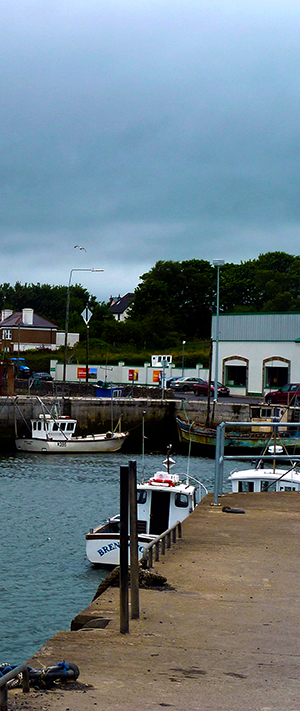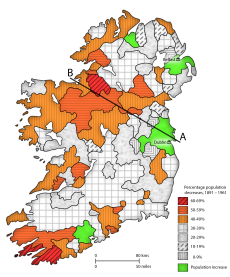👉 Find out about The Open University's Geography courses. 👈
 Killala Harbour
Throughout these articles on Uniqueness, Interdependence, Uneven Development and Change in the West of Ireland, the concept of synthesis is used as a way to understand how places are continually evolving while retaining their uniqueness. This may sound complicated at first, but can perhaps best be approached by applying the idea to a familiar real-world example.
Killala Harbour
Throughout these articles on Uniqueness, Interdependence, Uneven Development and Change in the West of Ireland, the concept of synthesis is used as a way to understand how places are continually evolving while retaining their uniqueness. This may sound complicated at first, but can perhaps best be approached by applying the idea to a familiar real-world example.
To begin, think about the area where you live, or another which you know well. What makes it unique? It will be made up of a combination of elements, old and new, representing changes that have taken place both locally and in wider society. Try to identify some of these different aspects which combine in a distinctive way to give the area its character. For example, there may be derelict factories or perhaps a new industrial estate, new shopfronts on old houses, new main roads through old residential areas, new houses on land up until recently farmed, old farm buildings housing modern machinery. Look out for how these mixtures of old and new are bound together with the ‘character' of the place: its social composition, its historical legacy, and its role in a changing national economic pattern.
Synthesis
The way in which places retain their uniqueness within wider systems of interdependence is an important methodological issue within geography and is approached through the method of synthesis. This is a way of explaining:
- how the different elements of society are linked together in any one particular place and,
- how links between places, for example particular kinds of housing, industry and agriculture, in any one area are part of wider geographical patterns. Each area is a particular focus of activities within a wider system of interdependencies; in a sense each area has a ‘role’ within the wider system.
The notion of synthesis is cumulative. It helps us to understand how, in the process of change, some things may be lost as others are gained, exchanged or modified. Examples might be the loss of traditional agricultural practices, the gain of modern communications networks, abandonment of local traditional building methods in favour of mass modern techniques and architectural style, or retention of local craft skills geared to modern tourism or new markets.
Moreover, what happens in particular places also has an effect on the wider system. Not only does the existing character of an area influence the ways in which general social processes operate in and affect that local area - the outcome of that interaction can also affect the way those processes operate elsewhere, even at a wider scale.
Layers
One way of understanding the ‘changing fortunes’ of an area over time, is to think of layers accumulating. Layers are different combinations of characteristics that are new and specific and never quite the same as somewhere else, and they can be seen at different scales, including the local and regional level.
New processes operate in the context of a particular historical period. Each happening - such as migration, a change in farming practices, a tourism initiative - is affected by and impacts on a particular place differently. New layers merge with, and build upon, the area’s existing characteristics, producing changes which will in turn affect the impact of the next happening. Each new layer starts as the combination of economic, political and cultural factors which themselves originate as processes within a wider social context. The ‘layers' represent the interaction between the local area and general social processes. You will discover that industrial restructuring not only operates at national and international levels, but also combines with specific features at a local level. For this reason, general processes do not produce similar outcomes indiscriminately over space. In other words, the new layer does not simply arrive and sit on top of the previous layer. The new layer interacts with the existing layer.
Synthesis
To recap, synthesis involves understanding the relationship between different analytical aspects both at one point in time and in terms of how they change over time. It involves more than just the sum of its parts.
Layers
Layers help us to understand how change takes place. One historical period is the context in which new processes operate. Each happening (e.g. emigration) is affected by and affects a particular place differently. Layers are different combinations of characteristics that are new and specific and never quite the same as somewhere else. They can be seen at different scales, including regional and local level.
Uniqueness and Interdependence
Although similar processes are experienced in many places, these places do not all become the same. Uniqueness arises from the different way in which these elements combine together and merge. This involves constant construction and re-construction of place, because these processes are occurring in the context of what was already there – the past geography of a place affects the present pattern.
At the same time, it must be recognised that the complex of changing patterns, out of which uniqueness is constructed, involves changing sets of interdependencies between one place and the world beyond.
The interaction between uniqueness and interdependence can help us to understand uneven development.
In short, as you will discover in these articles, the economic and political factors which combine to produce the location of a factory or a tourism initiative in a particular place, and the social and cultural implications which come with it, are not in themselves unique. What is unique is the specific combination of those factors within that particular place at that particular time. In the articles on Northeast Mayo and Southwest Donegal, you will find that the outcome of national processes, for example industrialisation, can be very different even within the same region. Each of these areas has its own uniqueness yet both are very unmistakably part of the West of Ireland.
The construction of new layers is about the combination, over time, of new elements with existing circumstances; that is, it is about the process of local social change. Each layer is unique; each place is unique; but as they accumulate over time, the uniqueness changes.
Learning Outcomes
After completing this series of articles, you will be able to:
- Recognise how the different elements of society are linked together in any one particular place
- Apply the method of synthesis to explain how places in rural Ireland retain their uniqueness within evolving systems of interdependence
- Recognise how links between places, are part of wider geographical patterns
- Identify how uneven development in the West of Ireland has both persisted and changed over time.
- Apply the geographical concepts of uniqueness and interdependence of place to other locations with which you are familiar.












Rate and Review
Rate this activity
Review this activity
Log into OpenLearn to leave reviews and join in the conversation.
Activity reviews